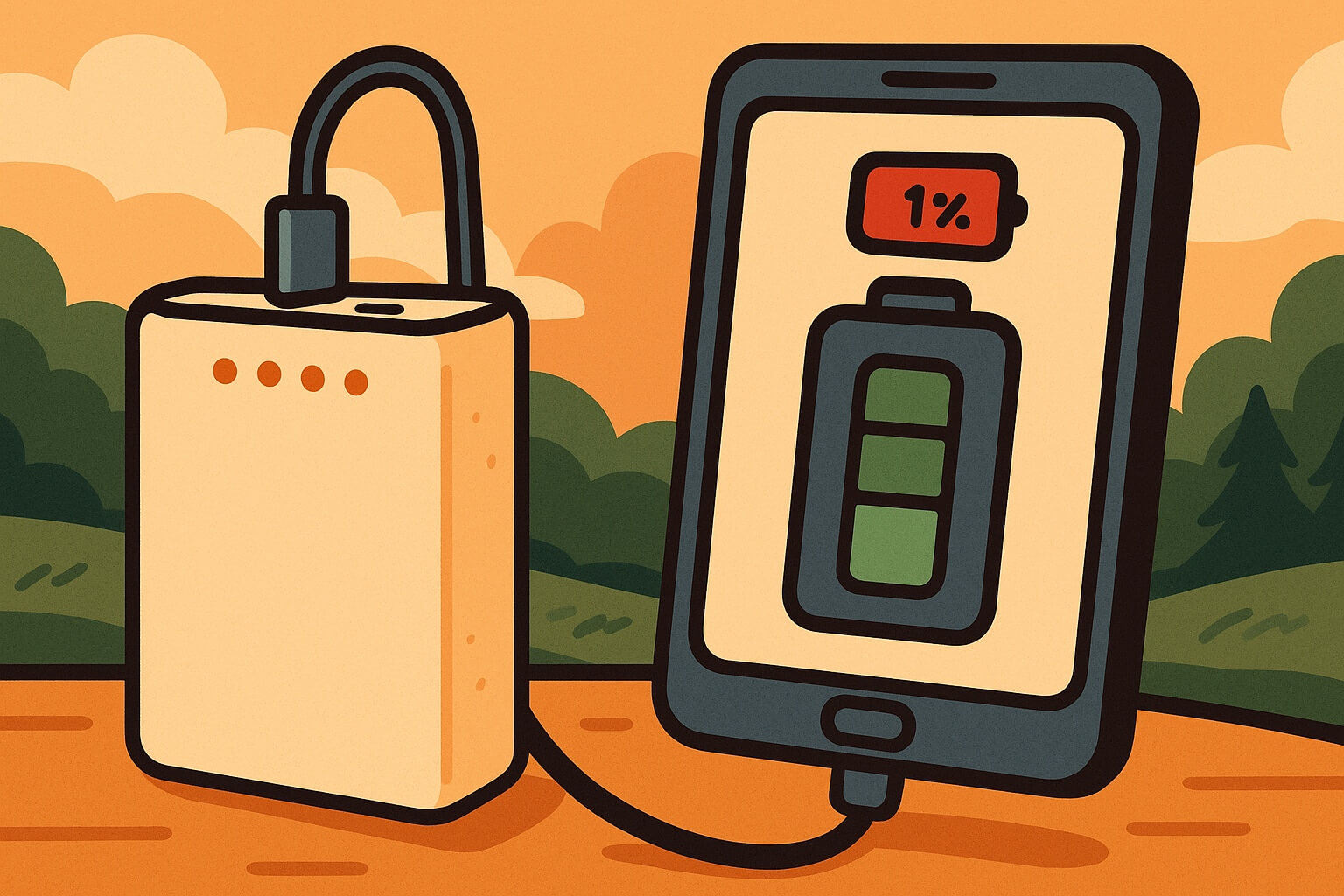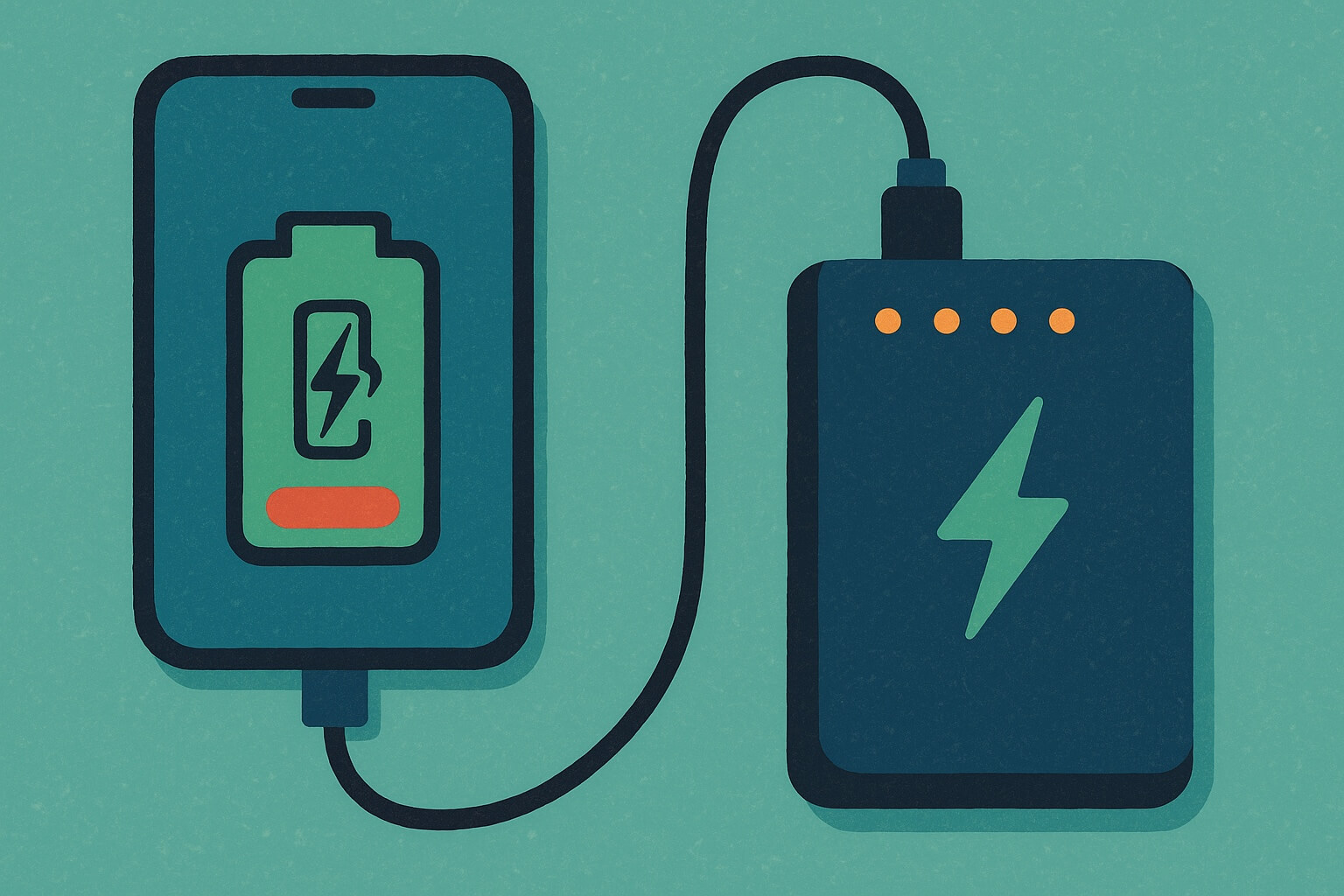
Is there anything worse than your phone dying mid-Google Maps in a new city? Maybe running out of battery and having two kids asking when lunch is. Or maybe watching 3% tick down during a delayed flight. Either way—enter the humble, heroic portable charger.
Also known as power banks, these little battery bricks are the unsung MVPs of modern life. Often referred to as battery packs, they are essential for on-the-go charging and emergencies, making sure your devices stay powered when you need them most. Whether you’re traveling, camping, working remote, or just living in a house where someone always “borrows” your charger, a good power bank is no longer a nice-to-have—it’s essential.

But here’s the thing: not all portable chargers are created equal. Some charge slow. Some won’t even work with your laptop. And some are just overpriced doorstops with a USB port.
That’s why we tested a ton of them—so you don’t waste your money (or run out of battery when it matters most). Let’s plug in.
Best Portable Chargers in 2025 (We Tried It Picks)
Scroll-stopping, phone-saving, travel-tested favorites.
We tested a ridiculous number of portable chargers (so many, our power strips now qualify as fire hazards). Here are the best of the best, broken down by what you actually need them for: These are our picks for the best power banks, selected after comparing and evaluating other portable chargers from a wide range of brands and models.
? Best Overall Portable Charger
Anker 737 Power Bank
Want some serious, portable juice? Use the Anker 737 to power your iPhones, iPads and even Macbook Pro!
- Capacity: 24,000mAh
- Output: Up to 140W via USB-C (yes, it can charge your MacBook)
- Why we love it: Charges everything, fast. Premium build, bright display, great for travel or work. You can press the power button to check the device status or view the current charge level on the display.
- Downside: It’s chunky. Not pocket-friendly, unless you wear cargo pants like it’s 1999.
- Best for: Power users, travelers, laptop folks
? Best for iPhone Users
Anker Nano Power Bank (with Built-In Cord)
Offers a variety of built in cable options to fit your device models.
- Capacity: 5,000mAh
- Why we love it: It plugs directly into your iPhone—no cords, no drama. With its built-in Lightning port (or USB-C port, depending upon model), this power bank is designed specifically for devices with a specific ports, making it fully compatible with iPhones and other Apple devices that use this connection.
- Downside: Won’t fully charge your phone twice, but great for top-ups.
- Best for: Everyday carry, Airplane mode emergencies, busy days
? Best for Android Users
INIU 10000mAh Slim Power Bank
Build in cord and fast charge at a great price, what else do you want?
- Capacity: 10,000mAh
- Why we love it: Fast charging with USB-C, affordable, super thin. This model is a true power bank 10k, offering a compact size that makes it perfect for daily use while still providing enough capacity for multiple charges.
- Downside: No wireless charging, but we’ll live.
- Best for: Daily use, budget-conscious buyers
? Best for Laptops
Baseus Blade 100W Power Bank
Slim and full of power, this power bank really packs a big punch.
- Capacity: 20,000mAh
- Output: Dual USB-C, 100W charging
- Why we love it: This power bank can charge laptops efficiently, thanks to its high 100W output and compatibility with various laptop brands, including fast-charging for devices like the MacBook Pro. Sleek design, and it’s shockingly light.
- Downside: Pricey, but cheaper than running out of battery during a Zoom call.
- Best for: Digital nomads, remote workers, students
? Best for Travel
Zendure SuperMini 20W
For a low price, you can enjoy a great travel charger.
- Capacity: 10,000mAh
- Why we love it: Airline-approved size, stylish, fast charging, and built like a tank. Perfect for giving your phone or tablet a quick top up while on the go.
- Downside: You’ll wish you had a second one for your kids’ tablets.
- Best for: Jet-setters, frequent flyers, conference-goers
? Best Solar-Powered Charger

BigBlue Solar Charger 28W
What if you're off the grid? Check out this solar-powered charger.
- Why we love it: Reliable solar panels, foldable, great for emergencies and camping.
- Downside: Not a battery—just solar panels. You’ll need sun and patience. Since it relies on sunlight as its power source, you must have access to a reliable power source like direct sunlight to recharge your devices.
- Best for: Campers, hikers, preppers
? Best Budget Power Bank
Miady 2-Pack 10,000mAh Power Banks
Low on budget but high on power needs? Check out this great deal.
- Capacity: 2x 10,000mAh
- Why we love it: You get two for less than the price of one big name brand. Each power bank can charge two devices at the same time, making it ideal for families or sharing. No-frills but effective.
- Downside: Slower charge speeds, basic build.
- Best for: Families, backup stash, emergencies
What Is a Portable Charger (aka Power Bank)?
Yes, it’s a battery for your battery.
A portable charger—also known as a power bank—is basically an external battery that stores energy and then transfers it to your devices when they’re running low. Think of it as a to-go box for electricity. Here’s how portable chargers work: they store electrical energy in their internal battery and then deliver that stored power to your devices through a cable or wirelessly, depending on the model.
Here’s the deal in plain English:
- ? It stores power when you plug it into the wall (using a USB-C, micro USB, or Lightning cable).
- ⚡ It gives that power back to your phone, tablet, laptop, or even your Nintendo Switch when you plug those devices into it.
- ? Some even support wireless charging, AC outlets (yes, for your laptop), and fast charging with USB-C Power Delivery.
They’re usually rated in mAh (milliampere hours)—a fancy way of saying, “how much juice does this thing hold?” This rating helps you determine how much charge each power bank can deliver to your devices before needing a recharge.
Capacity (mAh) | What it can do |
|---|---|
5,000 mAh | 1 full phone charge (ish) |
10,000 mAh | 2 phone charges or 1 tablet |
20,000+ mAh | Multiple devices or 1 laptop |
More mAh = more charging power = usually more size/weight. So, choose wisely.
Picking the right capacity depends on your lifestyle. For daily commutes, a 5,000mAh power bank is usually sufficient.
If you’re heading on a weekend camping trip, consider 20,000mAh or more. Power users juggling multiple devices should look towards higher capacity options. They offer enough juice to keep everything running smooth. It’s essential to align your power bank’s capacity with specific needs.
For instance, students may find a 10,000mAh power bank ideal for a full day at school. For families, a higher capacity can juggle multiple devices, from phones to tablets, keeping everyone happy and connected. By understanding your unique recharge needs, you can choose a power bank that fits right into your lifestyle.
Are Portable Chargers Allowed on Planes?

Yup! But there are limits:
- Under 100Wh? You’re good to go in your carry-on.
- Over 100Wh? Some airlines require approval.
- Checked bags? Hard no. Lithium batteries and airplane cargo don’t mix.
Basically, if your power bank is the size of a brick and can jumpstart a car… maybe don’t bring it through TSA.
Environmental Impact and Recycling
As demand for portable chargers increases, so does the need for environmentally friendly practices. Many brands are stepping up with recycling programs to minimize waste.
Using recyclable materials and offering take-back initiatives helps decrease the impact on our planet. Consumers are encouraged to recycle old power banks to keep harmful materials out of landfills. With our increasing reliance on portable chargers, eco-friendly disposal is more important than ever.
Lithium-ion batteries contain materials that can harm the environment. Recycling these batteries helps prevent toxic waste from entering landfills. Many companies now offer recycling options for their products, promoting a more sustainable approach.
As consumers, opting for brands with take-back schemes and eco-friendly packaging supports greener practices. This commitment to recycling not only protects the environment but also helps conserve valuable resources.
Types of Portable Chargers (And Who They’re Best For)

Because one size does not fit all when your laptop, phone, and smartwatch are all at 5%.
Not all portable chargers are built the same. Some models offer multiple ports, allowing you to charge several devices at once for added versatility. Some are designed to slide into your skinny jeans. Others could double as doorstops. Here’s a breakdown of the main types—and which one is best for your situation.
? Standard Power Banks (a.k.a. Everyday Carry Heroes)
- What they are: Your classic 5,000–10,000mAh bank with USB ports. Many models feature a single USB-C port, offering straightforward and reliable charging for your devices.
- Best for: Phones, earbuds, small tablets.
- Why we like them: Compact, affordable, easy to toss in a bag. Great for commutes, day trips, or your “just in case” drawer.
? High-Capacity Power Banks (a.k.a. Laptop Lifesavers)
- What they are: 20,000mAh+ monsters with 65W–140W USB-C output.
- Best for: Laptops, iPads, Steam Decks, multiple phones.
- Why we like them: They can actually charge a MacBook or Surface Pro. Their higher capacity means you can charge multiple devices or enjoy extended usage times without needing to recharge the power bank frequently. Perfect for remote work, travel days, or pretending to “unplug” in a cabin while bingeing Netflix.
? Solar-Powered Chargers (a.k.a. Survivalist Flex)
- What they are: Portable panels that convert sunlight into usable power.
- Best for: Camping, hiking, prepping for the apocalypse.
- Why we like them: Eco-friendly and off-the-grid friendly. Just don’t expect lightning-fast charging—these take patience and sunshine. It’s important to use the correct charging cable to connect your device to the solar charger, ensuring compatibility and efficient charging.
? Wearable & Keychain Chargers (a.k.a. Emergency Juice)
- What they are: Tiny chargers that clip onto your keychain or tuck into your wallet. Some models feature just one USB port, offering quick and simple charging with a minimalist design.
- Best for: One quick charge when you’re in a bind.
- Why we like them: You’ll forget you’re carrying one—until you’re desperately glad you are.
? Built-in Cable Power Banks (a.k.a. Cord-Free Convenience)

- What they are: Power banks with integrated Lightning, USB-C, or micro USB cables.
- Best for: People who always forget charging cords (you know who you are).
- Why we like them: No extra cords to remember, untangle, or accidentally leave at home. Many models feature a built-in USB C cable, making it quick and easy to charge your USB-C devices without carrying extra accessories. Great for minimalist travelers.
Portable power banks thrive on one main characteristic, portability. Sleek, compact designs ensure they easily fit into your bag or pocket without fuss. Travelers and busy commuters count on these handy devices that offer power without the bulk.
The best portable chargers won’t weigh you down on your busiest days. A lightweight and compact power bank is your best friend in today’s fast-paced world. Urban dwellers, for instance, appreciate having their devices powered up during hectic commutes.
For students, a portable power bank ensures their tech stays charged from morning classes to late-night study sessions. Compact designs featuring foldable plugs or built-in cables take portability a step further, fitting into even the tightest spaces. This focus on portability allows power banks to fit naturally into our daily routines, ensuring they’re ready whenever you need them.
This is the portable charger that I used all throughout our Disney World Trip.
Offers a variety of built in cable options to fit your device models.
Innovative Features in Modern Power Banks
Modern power banks come packed with innovative features. Wireless charging is no longer a luxury but a standard in many models. Some even boast integrated solar panels for off-grid adventures.
Digital displays showing battery levels help keep you informed. Today’s power banks are more than mere battery packs. They come equipped with advanced features like fast charging technologies that adapt to different devices.
Some models offer multi-device charging, catering to our varied gadget collections. Integrated solar panels provide off-grid charging solutions, perfect for outdoor enthusiasts. Many modern power banks include built-in security features, such as overcharge protection and short circuit prevention, ensuring they operate safely and efficiently. These innovations transform power banks from basic utilities into versatile, reliable companions in our tech-savvy world.
⚡ Wireless Charging Power Banks (a.k.a. Cordless Cool Kids)
For a low price, you can enjoy a great travel charger.
- What they are: Banks with a Qi charging pad for wireless-capable phones that let you wirelessly charge compatible devices, such as iPhones and AirPods.
- Best for: Newer iPhones, Samsung Galaxy phones, or AirPods with wireless cases.
- Why we like them: No fumbling with ports—just plop your phone on top and go.
How to Choose the Best Portable Charger
Because “anything on Amazon with 4 stars” is not a strategy.

With 47,000 different portable chargers on the market (okay, slight exaggeration), picking the right one can feel like trying to order a coffee at Starbucks for the first time. USB-C? Fast charge? 20,000 what now? It’s worth noting that factors like charging speed, capacity, and compatibility are key considerations when choosing the best portable charger for your needs.
Here’s how to make sense of the madness:
? 1. Know What You Need to Charge
Different devices = different demands.
- Phone only? 5,000–10,000mAh is plenty, and this capacity is enough to fully charge most smartphones at least once.
- Tablet or Nintendo Switch? Go 10,000–20,000mAh.
- Laptop or multiple devices? 20,000mAh+ and 65W+ output is your new best friend.
Quick hack: A phone charge uses ~2,500mAh. A MacBook Pro? ~8,000–10,000mAh.
⚡ 2. Check Charging Speed (a.k.a. Wattage Matters)
- Standard charge = ~5W (slow like your grandma’s Wi-Fi).
- Fast charge = 18W or more.
- Laptop charging = Look for USB-C Power Delivery (PD) with at least 45W–100W.
Different portable chargers offer varying charging speeds, which can significantly impact how quickly your devices—like smartphones and laptops—are recharged. Choosing a charger with higher charging speeds means less waiting and more convenience, especially when you need a quick power boost.
Tip: Don’t just check what the charger can output—make sure your device can actually accept it too.
? 3. Get the Right Ports
- USB-A: Still everywhere. Still useful. Multiple USB A ports allow you to charge several devices at once, increasing compatibility with older and current devices.
- USB-C: The future (and the present). Look for a USB C port or even two for the fastest recharging and broad device support. Models with more than one USB C port can charge high-power devices like laptops efficiently.
- Charging ports: The number and type of charging ports matter. Devices with three ports (typically two USB-C and one USB-A) let you charge multiple devices simultaneously, offering versatility and convenience.
- Built-in cables or wireless pads: Handy, especially when you forget stuff (aka all of us, always).
Pro-tip: Just get an adapter like this one:
? 4. Size and Weight: Will You Actually Carry It?
That high-capacity charger with 87 ports? It’s also the size of a brick.
- For your pocket: Stick to 10,000mAh or less.
- For your backpack or carry-on: 20,000mAh+ is doable.
- For actual pants pockets? Only if you miss the cargo short era.
Keep in mind, using a thick case on your phone may affect the fit or wireless charging capabilities of some portable chargers, especially those designed for MagSafe or wireless charging.
?️ 5. Build Quality and Bonus Features
- Look for: solid casing, clear battery indicator (bonus if it’s digital), reliable brand.
- Nice-to-haves: passthrough charging, auto shutoff, smart charging (PPS), LED flashlight if you’re outdoorsy, LED lights for status indication or usability in low-light conditions.
?️ 6. Brand Reputation & Warranty
That $12 off-brand charger with no reviews? Hard pass.
Stick to trusted brands (Anker, Baseus, Mophie, etc.) that offer real customer support and warranties longer than “until it ships.”
? TL;DR – Ask Yourself:
- What am I charging?
- How fast do I need it to charge?
- Do I need this in my pocket or just my travel bag?
- Do I trust this thing not to fry my phone?
Answer those and boom—you’ll know exactly what power bank to buy (or at least, which ones to ignore).
Portable Charger Comparison Table
Compare the top picks side-by-side, because specs shouldn’t feel like a math test.
Here’s a quick look at our favorite portable chargers, what they’re best for, and how they stack up:
Product | Capacity | Power Output (W) | Ports | Devices Simultaneously | Best For | Approx. Price |
|---|---|---|---|---|---|---|
Anker 737 Power Bank | 24,000mAh | 140W (USB-C PD) | 2x USB-C, 1x USB-A | Up to 3 devices simultaneously | Charging laptops & everything else | $149 |
INIU 10000 Slim | 10,000mAh | 22.5W | USB-C, 2x USB-A | Up to 3 devices simultaneously (features two USB-A ports) | Daily phone charging | $25 |
Baseus Blade 100W | 20,000mAh | 100W | 2x USB-C, 2x USB-A | Up to 4 devices simultaneously (features two USB-A ports) | MacBook & tablets | $99 |
Zendure SuperMini | 10,000mAh | 20W | USB-C, USB-A | 2 devices simultaneously | Travel & carry-on use | $49 |
BigBlue Solar Charger | N/A (solar panel only) | N/A | USB-A x2 | 2 devices simultaneously (features two USB-A ports) | Camping & off-grid | $69 |
Anker Nano (Lightning) | 5,000mAh | 12W | Built-in Lightning | 1 device | Emergency iPhone top-ups | $30 |
Miady 2-Pack | 10,000mAh (each) | 12W | USB-C, USB-A | 2 devices simultaneously | Budget option for families | $25 for two |
Note: Prices vary depending on sales, bundles, or cosmic alignment. Always check before you click “Buy.”
How to Maintain and Troubleshoot a Portable Charger
Because even your power bank needs a little TLC.
Your portable charger is like that friend who always shows up when your phone’s dying at 2%. Don’t ghost them. Treat them right and they’ll return the favor for years. Make sure your power bank is fully charged before heading out, so you’re always prepared.
Here’s how to keep your power bank performing like a champ—and what to do when it starts acting shady. When recharging your power bank, monitor the charging time to avoid overcharging and ensure efficient performance. If you run into issues, double-check that your devices are properly connected and securely plugged in to the correct ports. Connecting your power bank to a reliable power source with the right cable also helps maintain optimal charging.
?️ How to Maintain Your Portable Charger

✅ 1. Charge It Before You Actually Need It
Don’t toss it in your bag at 12%. A good rule of thumb? Charge it every couple of months, even if you’re not using it regularly. Lithium-ion batteries hate being lonely and empty
?️ 2. Avoid Extreme Temperatures
Leaving your charger in a hot car = battery drama.
Freezing temps = sad, slow charging.
Keep it between 32°F and 95°F (0°C–35°C) for optimal performance.
? 3. Keep It Dry
Even “rugged” power banks don’t usually enjoy a swim. If it’s not waterproof, don’t treat it like it is.
⚡ 4. Use Quality Cables and Wall Adapters
Don’t plug a $100 power bank into a $3 wall wart from 2012. Bad power in = bad power out.
? Common Portable Charger Problems (and Fixes)
It’s Not Charging My Device
- Try a different cable or port.
- Make sure the charger itself is powered on (some require a button press).
- Double-check the output wattage—it may not be strong enough for your device.
It’s Not Holding a Charge
- Could be a dying battery. Try a full charge cycle (0% → 100%).
- If it still drains fast, it might be time for a replacement.
It Won’t Recharge Itself
- Try another wall adapter and cable.
- Check the input port—is it loose or damaged?
- Still stuck? Some power banks have a reset button or combo (check the manual or the brand’s support site).
It’s Overheating or Expanding (Yikes!)
Stop using it immediately. That’s a lithium battery issue—and not the fun kind. Dispose of it properly at an e-waste center.
Bonus: How to Store It Right
- Store it at around 50% charge if you’re not using it for a while.
- Keep it in a cool, dry place—not the glove box or your bathroom drawer.
TL;DR: Treat your charger like a mini electronic pet—don’t leave it in the sun, don’t let it starve, and don’t feed it trash cables.
Final Thoughts: Stay Charged, Stay Sane
Your devices deserve better than 3% and a prayer. They deserve portable power banks that give you a lot more than 3%.
Want some serious, portable juice? Use the Anker 737 to power your iPhones, iPads and even Macbook Pro!
Let’s be honest: running out of battery is the modern version of getting stranded on the side of the road. Whether you’re traveling, wrangling kids at the zoo, or mid-Zoom call in a coffee shop with exactly one outlet—a portable charger is your get-out-of-jail-free card. With the right power bank, you can stay connected and keep not just your phone, but other devices powered up wherever you are.
The good news? There’s a power bank out there for every need, every budget, and every level of tech obsession. Advanced models like the Clutch Pro and the Anker laptop power bank use cutting edge technologies and offer large capacity options to meet demanding charging needs. The bad news? There are also a bunch of overpriced, underpowered duds waiting to disappoint.
Here’s the cheat sheet:
- Match the charger to your device (don’t try to juice a laptop with a lipstick-sized power bank).
- Check the output wattage if you want fast charging—not just “eventually charging.”
- Choose a size you’ll actually carry, not one that’ll sit at home in your “tech drawer of shame.”
- Consider the trade off between size, capacity, and portability—large capacity models are great for extended use, but may be bulkier.
Buy smart, charge smart, and your future self (and future phone battery) will thank you.









